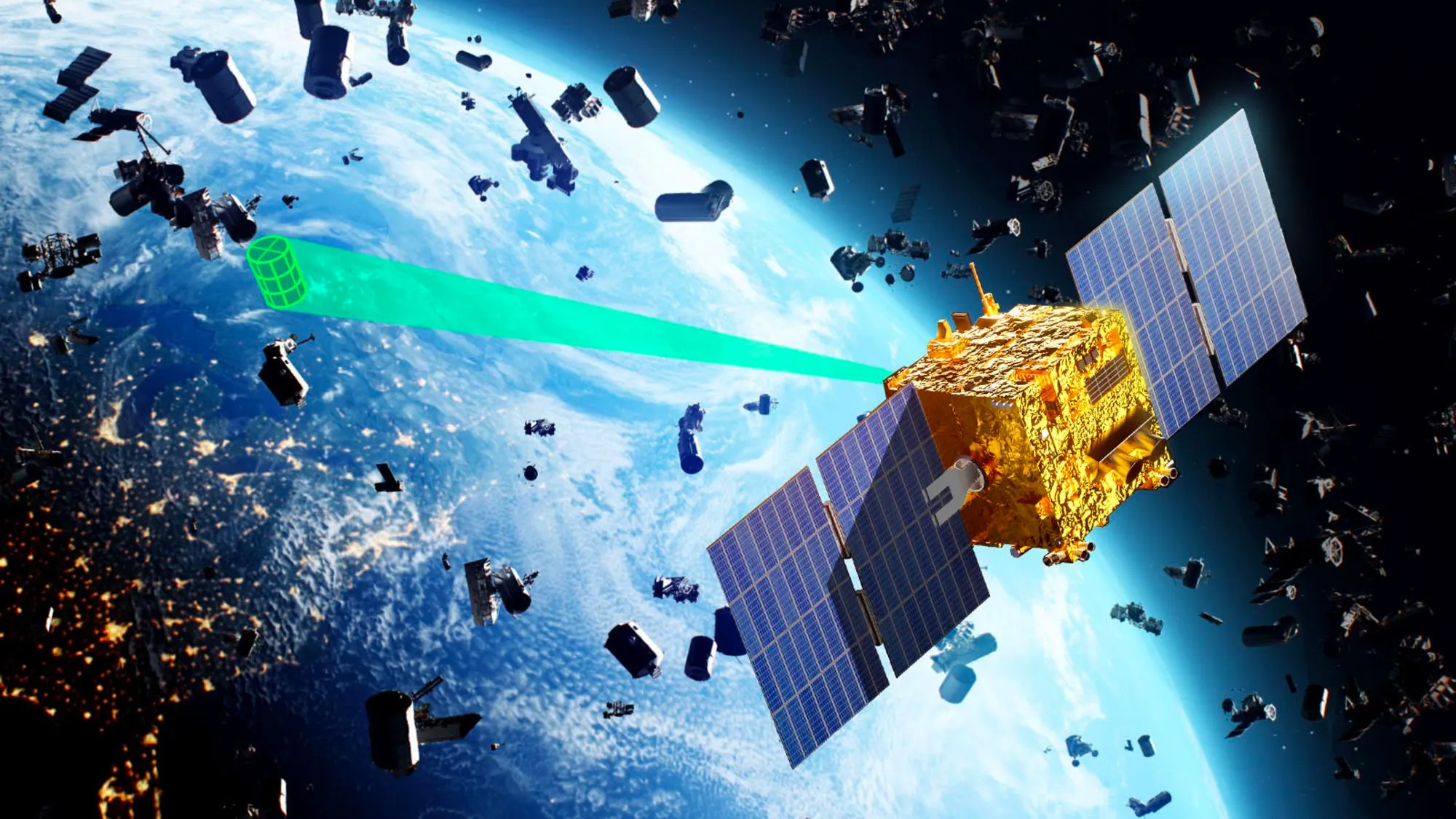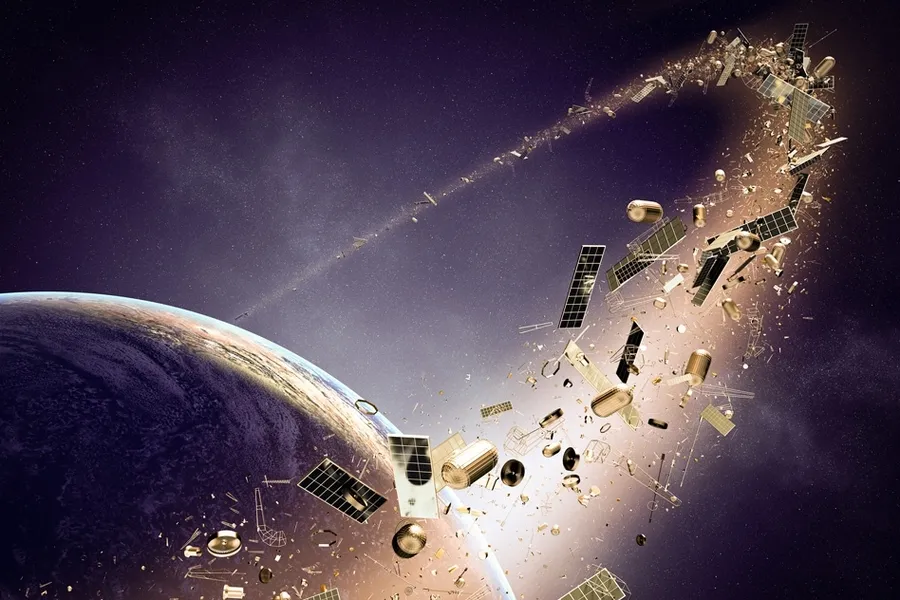How Space Junk Threatens Future Missions and Satellites

Space junk, the debris cluttering Earth’s orbit, poses a growing menace to satellites, space missions, and our ambitions for cosmic exploration.
Anúncios
Every defunct satellite, stray bolt, or paint fleck zipping through orbit at 17,500 miles per hour carries the potential to wreak havoc.
As humanity’s presence in space expands—think megaconstellations like Starlink or lunar gateways—the risks tied to this orbital clutter escalate.
This article dives into why orbital debris is a ticking time bomb, how it jeopardizes international tensions, and what innovative solutions might keep our skies clear for future ventures.
Can we afford to ignore this invisible threat circling above us?
The Invisible Swarm Above Us
Picture a highway packed with cars, but instead of crawling traffic, every vehicle rockets at hypersonic speeds, and no one’s steering.
That’s Earth’s orbit today. Orbital debris ranges from defunct satellites to fragments from collisions or explosions.
A single mishap, like the 2009 collision between a Russian Cosmos satellite and an Iridium spacecraft, generated thousands of trackable fragments.
NASA’s Orbital Debris Program Office estimates over 27,000 objects larger than a tennis ball are monitored, but millions of smaller pieces—too tiny to track—lurk undetected.
These specks, moving faster than bullets, can puncture spacecraft or disable critical systems.
The danger isn’t theoretical.
In 2021, the International Space Station (ISS) dodged a piece of debris from a Chinese anti-satellite test.
Such near-misses are routine, forcing crews to brace for potential evacuations.
Satellites, lacking human reflexes, are even more vulnerable.
A single strike could knock out GPS, weather forecasting, or internet services billions rely on.
The stakes are clear: unchecked debris threatens not just space assets but the terrestrial systems we take for granted.
Table 1: Sources of Orbital Debris
| Source | Percentage of Total Debris | Example Impact |
|---|---|---|
| Defunct Satellites | 40% | Risk of large-scale collisions |
| Rocket Bodies | 20% | Fuel explosions create fragments |
| Mission-Related Debris | 15% | Bolts, tools from spacewalks |
| Fragmentation Events | 25% | Anti-satellite tests, collisions |
+ Nuclear Propulsion: Accelerating Deep Space Travel
The Cascade Effect: A Domino Disaster
Imagine dropping a glass on a tile floor.
The shards scatter, each capable of cracking another glass.
In orbit, this is called the Kessler Syndrome, a scenario where collisions breed more debris, triggering a chain reaction that renders orbits unusable.
Proposed by NASA scientist Donald Kessler in 1978, this theory looms larger as orbits grow crowded.
Low Earth Orbit (LEO), home to most satellites, is particularly at risk.
A 2023 study by the European Space Agency (ESA) warns that without intervention, LEO could become a no-go zone by 2050, locking out launches and strangling space-based services.
Consider a hypothetical: a defunct weather satellite shatters after hitting a stray bolt.
The resulting cloud of fragments strikes a telecom satellite, which splinters further.
Within weeks, a dozen more assets are damaged, disrupting global communications.
This isn’t science fiction—it’s a plausible future if we don’t act.
The 2009 Cosmos-Iridium crash alone boosted debris counts by 10%, a stark reminder of how one event can spiral.
With private companies like SpaceX planning to launch tens of thousands of satellites, the odds of such cascades climb higher.

Economic and Geopolitical Ripples
Beyond physical risks, orbital clutter stirs economic and diplomatic tensions.
Satellites underpin a $400 billion space economy, from navigation to banking.
A single collision could cost operators millions in repairs or replacements, spiking insurance premiums and deterring investment.
For nations, space is a strategic domain.
Debris from anti-satellite tests, like China’s 2007 demonstration, fuels mistrust, as fragments threaten all players’ assets.
Accusations fly: was that debris cloud an accident or a veiled act of sabotage?
Geopolitics complicates cleanup.
No nation owns orbit, yet all contribute to its mess.
International agreements, like the Outer Space Treaty, urge responsible behavior but lack enforcement teeth.
Imagine a fictional scenario: a U.S. startup’s satellite is crippled by debris from a Russian test.
Who pays? Who cleans it?
These questions spark diplomatic standoffs, delaying solutions.
Meanwhile, emerging spacefaring nations like India add to the clutter, asserting their right to orbit.
Without global cooperation, the tragedy of the commons unfolds in real time.
Table 2: Key Players in Orbital Debris Generation
| Country/Entity | Notable Debris Events | Current Mitigation Efforts |
|---|---|---|
| United States | Early rocket explosions | NASA debris tracking, guidelines |
| Russia | 2009 Cosmos-Iridium collision | Limited transparency |
| China | 2007 ASAT test | Developing cleanup tech |
| Private Companies | Megaconstellations | End-of-life deorbit plans |
++ The Ethics of Terraforming and Planetary Engineering
The Human Cost of Inaction
Why should we care about a problem 500 miles above?
Because space junk doesn’t stay in space forever.
Larger objects, like rocket stages, often survive reentry, posing risks to populated areas.
In 2022, a 25-ton Chinese rocket booster crashed uncontrolled over the Indian Ocean, sparking outrage.
While no one was harmed, the incident underscored a grim reality: debris can turn into terrestrial hazards.
With over 60% of Earth’s population living in urban areas, the odds of a catastrophic impact grow.
Astronauts face even graver dangers.
A 1-centimeter fragment could pierce a spacesuit during a spacewalk, endangering lives.
The ISS, humanity’s outpost in orbit, has maneuvered over 30 times since 1999 to avoid collisions.
Each dodge burns fuel, shortening the station’s lifespan.
For future lunar or Martian missions, debris in higher orbits could jeopardize transit routes.
The Artemis program, aiming for lunar landings by 2026, must navigate this gauntlet.
Ignoring the problem now could strand our cosmic dreams.

Innovative Solutions on the Horizon
Tackling orbital debris demands creativity and collaboration.
Active Debris Removal (ADR) technologies are gaining traction.
Companies like Astroscale are testing robotic arms to capture defunct satellites, guiding them to burn up in the atmosphere.
Another approach, laser-based nudging, uses ground stations to slow debris, hastening its reentry.
These methods, while promising, face hurdles: high costs and legal gray zones over “touching” another nation’s debris.
Prevention is equally critical.
New satellites now include deorbiting mechanisms, like sails or thrusters, to ensure they don’t linger post-mission.
SpaceX’s Starlink satellites, for instance, are designed to deorbit within five years of retirement.
Yet, compliance varies.
Only 60% of satellites launched in 2022 followed UN guidelines for end-of-life disposal, per ESA data.
Stricter regulations, paired with incentives like tax breaks for compliant operators, could close this gap.
For further reading on the implications of space debris and potential solutions, visit NASA’s Orbital Debris Program.
A Call for Collective Responsibility
What will it take to safeguard our orbital frontier?
The answer lies in shared accountability.
Nations must strengthen treaties, mandating debris mitigation and funding cleanup.
Private companies, reaping profits from space, should invest in sustainable practices.
Even individuals can advocate—supporting policies or companies prioritizing orbital health.
Imagine a future where orbits are as clean as alpine lakes, enabling safe exploration for generations.
That vision hinges on action today.
Space junk isn’t just a technical glitch; it’s a test of humanity’s foresight.
Every fragment orbiting Earth reflects our choices—past negligence and future resolve.
By embracing innovation, diplomacy, and responsibility, we can clear the skies for satellites, astronauts, and dreamers alike.
The cosmos awaits, but only if we sweep our doorstep first.
